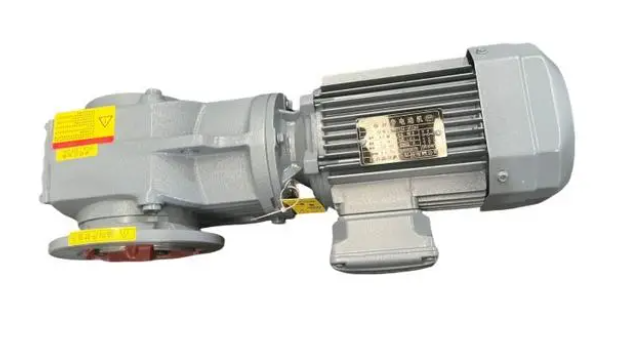A brief discussion on the classification and characteristics of helical gear reducers

The classification and characteristics of helical gear reducers play a crucial role in modern mechanical transmission equipment. Among them, helical gear reducers have attracted much attention due to their superior performance and wide applications. This article will explore in detail the classification, characteristics, and industrial applications of helical gear reducers, providing readers with a comprehensive understanding.
1、 Overview of helical gear reducerA helical gear reducer is a reduction device that uses helical gears as key transmission components. Its basic function is to convert the high-speed and low torque output of an electric motor or other power source into low-speed and high torque output, thereby meeting the specific working requirements of mechanical equipment. Due to its unique tooth profile design, helical gears can effectively share the load, reduce vibration and noise during meshing, thereby improving transmission efficiency.
2、 Classification of helical gear reducers
According to different structures and functions, helical gear reducers can be divided into the following categories:
1. Classify by gear layout
-Parallel axis helical gear reducer: This is the most common type, where the gear shafts are placed parallel and suitable for situations with small space constraints. It has good load-bearing capacity and transmission efficiency.
-Cross axis helical gear reducer: This type of reducer is suitable for situations with large directional changes. The gear shafts are arranged at a certain angle in a cross pattern, which can better adapt to complex transmission requirements.
2. Classified by gear meshing form
-External helical gear reducer: The meshing of gears occurs on the outer side and is suitable for most mechanical transmissions, such as cranes, conveyors, etc.
-Internal helical gear reducer: The gears mesh internally and have a relatively small volume, which is often used in specific applications with limited space.
3. Classified by installation method
-Vertical installation reducer: suitable for occasions that require small ground space, widely used in equipment such as elevators and lifts.
-Horizontal installation reducer: Due to its simple structure and adaptability to various machinery, it is usually used for equipment such as fans and excavators.
4. Classify by functional characteristics
-Integral helical gear reducer: All components are compactly integrated together, which can effectively save space and is easy to install and maintain.
-Split helical gear reducer: easy to replace parts and maintain, suitable for heavy-duty equipment with high power and torque.
3、 Characteristics of helical gear reducer
Due to its unique design and manufacturing process, helical gear reducers have various significant features:
1. High transmission efficiency
The relative tooth contact angle of helical gears is relatively large, therefore, the contact surface can withstand higher loads. This design can reduce energy loss, making the transmission efficiency of helical gear reducers generally reach over 95%.
2. Smooth operation
Compared with spur gears, the meshing method of helical gears makes them smoother and quieter during operation. This makes helical gear reducers very suitable for equipment that requires low noise, such as packaging machines, food processing equipment, etc.
 Afrikaans
Afrikaans Shqip
Shqip አማርኛ
አማርኛ العربية
العربية Հայերեն
Հայերեն Azərbaycan dili
Azərbaycan dili Euskara
Euskara Беларуская мова
Беларуская мова বাংলা
বাংলা Bosanski
Bosanski Български
Български Català
Català Cebuano
Cebuano Chichewa
Chichewa 简体中文
简体中文 繁體中文
繁體中文 Corsu
Corsu Hrvatski
Hrvatski Čeština
Čeština Dansk
Dansk Nederlands
Nederlands English
English Esperanto
Esperanto Eesti
Eesti Filipino
Filipino Suomi
Suomi Français
Français Frysk
Frysk Galego
Galego ქართული
ქართული Deutsch
Deutsch Ελληνικά
Ελληνικά ગુજરાતી
ગુજરાતી Kreyol ayisyen
Kreyol ayisyen Harshen Hausa
Harshen Hausa Ōlelo Hawaiʻi
Ōlelo Hawaiʻi עִבְרִית
עִבְרִית हिन्दी
हिन्दी Hmong
Hmong Magyar
Magyar Íslenska
Íslenska Igbo
Igbo Bahasa Indonesia
Bahasa Indonesia Gaeilge
Gaeilge Italiano
Italiano 日本語
日本語 Basa Jawa
Basa Jawa ಕನ್ನಡ
ಕನ್ನಡ Қазақ тілі
Қазақ тілі ភាសាខ្មែរ
ភាសាខ្មែរ 한국어
한국어 كوردی
كوردی Кыргызча
Кыргызча ພາສາລາວ
ພາສາລາວ Latin
Latin Latviešu valoda
Latviešu valoda Lietuvių kalba
Lietuvių kalba Lëtzebuergesch
Lëtzebuergesch Македонски јазик
Македонски јазик Malagasy
Malagasy Bahasa Melayu
Bahasa Melayu മലയാളം
മലയാളം Maltese
Maltese Te Reo Māori
Te Reo Māori मराठी
मराठी Монгол
Монгол ဗမာစာ
ဗမာစာ नेपाली
नेपाली Norsk bokmål
Norsk bokmål پښتو
پښتو فارسی
فارسی Polski
Polski Português
Português ਪੰਜਾਬੀ
ਪੰਜਾਬੀ Română
Română Русский
Русский Samoan
Samoan Gàidhlig
Gàidhlig Српски језик
Српски језик Sesotho
Sesotho Shona
Shona سنڌي
سنڌي සිංහල
සිංහල Slovenčina
Slovenčina Slovenščina
Slovenščina Afsoomaali
Afsoomaali Español
Español Basa Sunda
Basa Sunda Kiswahili
Kiswahili Svenska
Svenska Тоҷикӣ
Тоҷикӣ தமிழ்
தமிழ் తెలుగు
తెలుగు ไทย
ไทย Türkçe
Türkçe Українська
Українська اردو
اردو O‘zbekcha
O‘zbekcha Tiếng Việt
Tiếng Việt Cymraeg
Cymraeg isiXhosa
isiXhosa יידיש
יידיש Yorùbá
Yorùbá Zulu
Zulu

